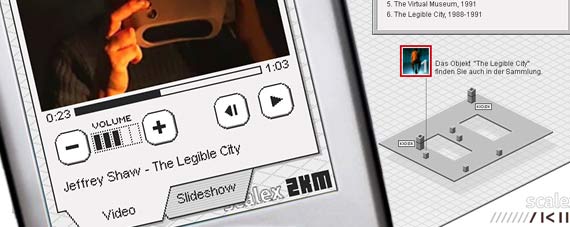Center for Culture & Communication, which was established in 1996 as a programme of the Soros Foundation Hungary, with the support of Matáv: the Hungarian Telecom and Silicon Graphics, as a consequence of its successful three-year experimental period has become an independent foundation under the name C3. The founders of the new, public institution are the Soros Foundation Hungary and Matáv. A number of companies have expressed an interest in supporting this new open foundation. With its registration, an institution has been established that, via its art and research programme, events and publications, has already contributed significantly to the support, recognition and development of digital culture, new communications technologies, the Internet and media art in Hungary, and continues to view this as its principal mission.
The aims of the C3 Foundation are the cultural application and creative employment of new scientific and technological discoveries, the research, development and support of innovative artistic potentials, and the initiation and realisation of art, science, communications, educational and cultural programmes.
Symptomatic of the 1990’s was the tendency for the challenges of ever-accelerating communications to lead to the birth of novel types of centers. C3 was Central/Eastern Europe’s first media institute, established synchronously with the foundation of other, similar European institutions (Ars Electronica Center - Linz, ZKM - Karlsruhe, V2 lab - Rotterdam).
The C3 programme of the Soros Foundation accomplished its duties which at the time of its establishment were aligned with the interest of the introduction and expansion of the Internet in Hungary. C3 provided several thousand NGO's and individuals with access, thanks to the support of Matáv; organised free courses; operated a public, free Internet "café"; and developed the web-based freemail service, as well as the prototype of the public WebTerminal as the result of collaborative research with the Matáv Research Institute, four copies of which were then placed in public locations. The new foundation continues to offer web-hosting capacity and support on our servers, and we provide Internet access services to 40 city libraries and numerous institutions via leased lines, with the support of the Soros Foundation and Matáv.
In accordance with the new challenges, and in preparation for the changes
in communications anticipated in the near future, C3 is transforming its public
programmes, which indicates primarily the presentation of the research and
potentialities of new, high-bandwidth technologies. We strive for mutually
beneficial collaborations in research and development with organisations focused
on the field of new communications applications; furthermore, our aim is to
incorporate sources of Hungarian and international grant-making bodies towards
the financing of our projects.
Deriving from the specific nature of the institution, the activities of C3
will focus on three primary areas: production, publication, and archiving
of electronic media, in an attempt to cover the widest range of creative applications
- including alongside the existing net-works, interactive multimedia and video.
All of this is complemented by cultural databases which cover just about every
creative domain of the application of communications media.
For Hungarian authors (also in collaboration with international parties) the
C3 Lab Grant program has signified and continues to signify an important opportunity,
in the framework of which - with the use of C3 equipment free of charge, as
well as technical assistance where necessary - media artworks and multidisciplinary
projects manifesting a novel approach to the understanding of contemporary
culture and communications are realised. The refreshed application, announced
twice annually, offers the creators of works in progress a multi-phased form
of cooperation, as a new element, which provides attentive care and management
of the project process, in the best possible sense.
In addition to fostering the creation of media art projects, C3 concentrates
its energies on publishing outstanding examples of Internet art on its website,
which presently receives 18-20 thousand hits daily. Notable representatives
of net.art have successfully participated in our residency programme, among
them award winners of international festivals. Another increasingly popular
public production of C3 is its Internet radio, ParaRadio.
C3 strives to inform the public about the latest achievements of media technology
and media art via lectures and presentations, symposia, workshops, and the
occasional but regularly organised small and large-scale exhibitions in cooperation
with partner institutions, as well as the appearance of publications both
in traditional and electronic media.
On the European and global level, a result of the past two years is the establishment and programmes of ENCART (European Network of Cyber Art), which comprises Europe’s largest-scale art institutions committed to independent media culture. An important element within our international relations is the artist-in-residency programme, a part of which includes EMARE (European Media Art Residency Exchange), financed by the European Kaleidoscope programme, and which comprises the exchange of artists between four countries (Germany, UK, Hungary and Finland), thus insuring research trips abroad for Hungarian artists.
In the future, C3 continues to consider the initiation and realisation of large-scale, public events as part of its mission, along the lines of the widely successful models of the 1996 Butterfly Effect, the 1999 Perspective, and the 2000 Media Model.
Key Persons:
Miklós Peternák, Director (peternak@c3.hu)Studied history and art history, graduated from the Eötvös Lorand University of Sciences and Arts, Budapest, in 1981, received Ph.D. degree in 1994
1981-83: curator, Hungarian National Gallery, Budapest
1983-87: researcher, Art Historical Research Team, Hungarian Academy of Sciences, Budapest
1987-97: guest professor, postgraduate Video and Communication Department,
Eötvös Lorand University of Sciences and Arts, Budapest
1990-: associate professor, head of the Intermedia Department, Hungarian Academy of Arts, Budapest
1997-: the general director of C3, shaping and supervising C3 programs and their theoretical backgrounds.
Márton Fernezelyi, Project coordinator (marci@c3.hu)
Márton Fernezelyi studied informatics at the Technical University of
Budapest, he is a programmer, system developer and teaches at the Intermedia
Department of the Hungarian Academy of Fine Arts. He supervises art and technology
projects at C3, he was one of the developers of Freemail and the WebTerminal.

